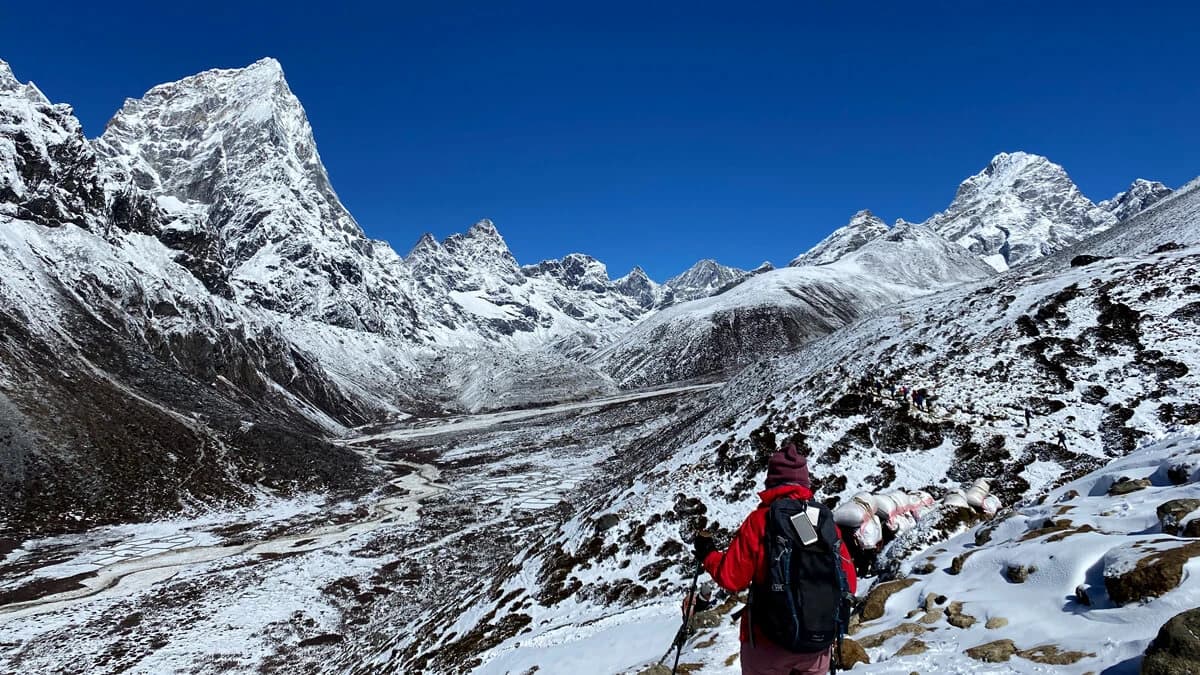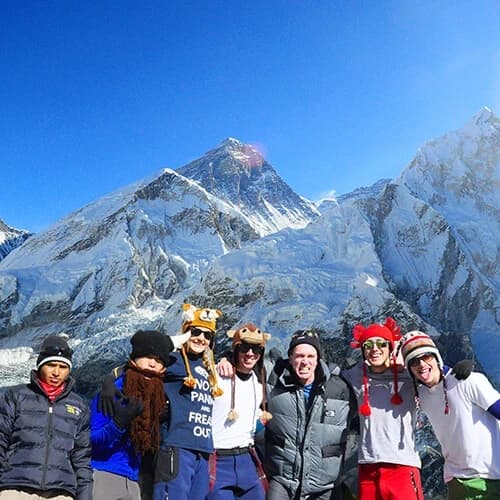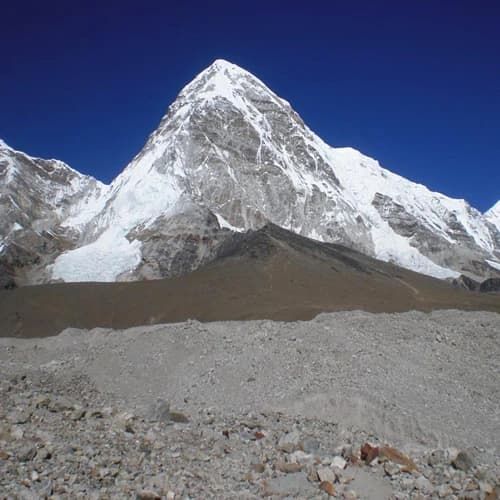Everest Base Camp Solo Trek is an exciting adventure to the heart of the Himalayas. Whether traveling solo or in a group, you are in for a visual spectacle and a journey of self-discovery. Solo trek to EBC offers unique experiences and freedom for those exploring the Everest region independently. It allows you to delve into the beauty of nature, enhancing your personal growth through a deep connection with the environment. This trek is an opportunity for self-discovery as it allows you to push your physical and mental limits, boosting your self-confidence. Additionally, the solar trek will enable you to personalize your adventure by setting a steady pace, choosing a suitable route, and making decisions based on your preference. But, traveling solo also imposes potential risks, including altitude sickness and getting lost. This blog will discuss several aspects of Everest Base Camp Solo Trekking and briefly overview what you should expect.
Everest Base Camp Solo Trek Guide
Can I Trek Solo to Everest Base Camp without a Guide?
You can trek solo to Everest base camp with a guide, or you can do it on your own, however, Hiring a licensed guide and creating a Trekking Information Management System (TIMS) card is mandatory. This new regulation is implemented for the safety of solo trekkers traveling through remote locations with limited connectivity and potential risks. The latest changes also support the local communities and help preserve Nepal's natural beauty. You can still trek solo, but you will need a guide. Professional guides provide invaluable insights, making your trek more enjoyable and accessible. The government's decision to conduct solo trekking in Nepal has changed the idea of trekking in Nepal by focusing on the trekker's safety and the growth of the country's economy through the tourism sector.
What can you expect during the EBC Solo Trek?
You'll immerse yourself in stunning Himalayan landscapes and local culture during the Everest Base Camp Solo Trekking. Diverse terrains with fantastic flora and fauna are the main highlights of the EBC trek. You'll pass through charming villages like Namche Bazaar and Tengboche, experiencing the warm hospitality of the Sherpa community. Accommodations range from basic tea houses to more comfortable lodges, providing a cozy resting place after long trekking days. The journey will test your endurance and mental strength. This fantastic trek offers breathtaking views of the Himalayas, valleys, glaciers, and vibrant Buddhist flags along the trail. Proper preparation and awareness of potential risks are crucial for a safe and enjoyable trek.
Everest Base Camp Solo Trek Essentials
Proper preparation is required before heading out on a solo trek. Solo trekkers should gather as much information as possible about all the trek requirements. It would help if you managed the necessary permits, proper trekking gear, means of transportation, and places for food, drinks, and accommodation for a successful trek. All the information about essentials for the EBC trek is discussed below.
Permits
Following administrative procedures is essential for your first EBC trek. You require two vital permits, which are as follows:
-
Sagarmatha National Park Permit
It is a compulsory permit for trekking in the Everest region. You can obtain it from the Nepal Tourism Board Office in Kathmandu. You can also get it at the entrance of the Sagarmatha National Park in Monjo. You must provide two passport-sized photos for this permit, which costs about $30.
-
Khumbu Pasang Lhamu Rural Municipality Permit
The Khumbu region requires this local permit, which can be obtained at Lukla or Monjo for about $20 and does not require photos.
Keep these two permits secure, as they are checked and stamped at various checkpoints during the trek. We recommend that you carry multiple photocopies and digital copies in case of loss or damage.
Trekking Gears
Packing the essentials for the Everest Base Camp Solo Trek can be confusing for a beginner. Considering the weather conditions and body weight, you should pack only the most needed gear. We recommend carrying an average weight of 25 kilograms per person. Carrying less weight makes your trek more accessible, whereas carrying more weight quickly leads to fatigue.
Some of the most essential gear for solo trekkers are listed below:
- Trekking boots
- Trekking poles
- Knee support
- Trekking trousers and shorts
- Breathable underwear
- Fleece jacket, insulated jacket, thermal inners, and base layers
- UV protected Sunglasses, sunscreen, hats, and lip balm
- Water bottle
Food and Drinks
Proper nutrition and hydration are crucial for a successful solo trek to Everest Base Camp. The tea houses and lodges along the trek offer a variety of meals. You will have three meals daily: breakfast, lunch, and dinner. Breakfast usually includes porridge, toast, eggs, cereals, fruits, and bread. You can enjoy various meals like dal bhat (rice with lentils), momo (dumplings), noodles, pasta, fried rice, potatoes, and soup for lunch and dinner. Additionally, carry high-energy snacks like nuts, dried fruits, energy bars, and chocolate for quick energy boosts between meals. Along with healthy food, proper hydration is also essential for solo treks. You must drink 3 to 4 liters of water daily. You can refill your water bottle at tea houses or natural sources using water purification tablets. You can also enjoy hot drinks like tea and coffee during the trek. Ginger tea and lemon tea are a popular choice for Acclimatization. Additionally, electrolyte drinks can help maintain your hydration levels. Make sure you avoid alcohol and caffeine at high altitudes. The cost of food and drinks varies with location and preference. The price of the foods get costlier as you move to higher altitudes. We recommend you manage a budget of $30 to $50 for daily food and beverages.
Accommodation
Accommodation is an essential part of the Everest Base Camp. After a long trek, travelers require a warm, comfortable, relaxing resting place. The trail's small lodges and tea houses offer basic amenities and a unique cultural experience. Don't expect luxurious rooms in the remote parts of the region, but the rooms in the lodges and teahouses are comfortable and help you rest and recover well. The simple rooms offer basic amenities, including shared rooms, single beds, limited furniture items, heater, electricity, and charging facilities. The establishments' toilets range from comfortable western flush toilets to basic squat toilets, depending on the location. Additionally, you can get other basic amenities, including a shared dining area, WI-Fi, hot shower, laundry, shops, stalls, and medical facilities. Accommodation costs range from $5 to $30 per night, depending on the location and altitude. Some of the famous towns and villages for accommodation are as follows:
- Lukla (2,860 meters)
- Phakding (2,610 meters)
- Manjo (2,835 meters)
- Namche Bazar (3,440 meters)
- Tyangboche (3,867 meters)
- Pangboche (3,985 meters)
- Dingboche (4,410 meters)
- Pheriche (4,371 meters)
- Gorakshep (5,164 meters)
Transportation
The primary means of transportation is a flight from Kathmandu to Lukla, which costs around $215. However, during peak season, you may not get flight tickets from Kathmandu. In such a case, you must take a bus, car, or jeep ride from Kathmandu to Manthali, Ramchhap, and catch a 15 to 20-minute flight to Tenzing Hillary Airport, Lukla, which costs around $175 to $180.
Insurance
Trekking to Everest Base Camp involves various risks, so travel insurance is essential. Your insurance must cover high-altitude trekking up to 5,500 meters, including emergency evacuation by helicopter. Medical coverage for altitude sickness, injuries, and other health problems is crucial. Verify that your policy includes trip cancellation, loss of baggage, and delays due to weather conditions. Proper insurance provides peace of mind, as you know you are prepared for any circumstances during your adventure.
Preparation
Proper preparation is the key to a successful solo trek to Everest Base Camp. You must indulge in physical training to build your stamina, focusing on cardiovascular exercises, strength training, and hiking practice. Manage proper trekking gear, including sturdy boots, warm clothing, and a comfortable backpack. Obtain the necessary permits, like the Sagarmatha National Park Permit and the Khumbu Pasang Lhamu Rural Municipality Permit. Plan your itinerary with the acclimatization days to prevent altitude sickness. Follow our guide for information on food, accommodation, and transportation. With all these measures, you can easily tackle the challenges of the EBC trek.
Everest Base Camp Solo Trek Advantages
Trekking is a journey of self-discovery, a chance to discover inner peace in the arms of nature. During a solo trek, you have the unique opportunity to explore at your own pace. You can indulge in the beauty of nature and gather new strengths and confidence. There are no time constraints and no one to rush you. This EBC solo trek allows you to move at your own pace and capture the beauty of the Himalayas. You can spend as much time as you want among the majestic mountains, free from external pressures. It's a true journey of relaxation.
Everest Base Camp Solo Trek Disadvantages
Major disadvantages include a communication gap among the locals and less knowledge about the surroundings, making the trek challenging. The absence of local language skills can lead to misunderstandings and locals taking advantage of your situation. A map and compass are essential during the trek, but your navigation skills must be sharp to interpret them correctly. Going off track can be time-consuming, frustrating, and devastating if you don't get help. Lack of food and water in such cases can be life-threatening, with the risk of getting sick at high altitudes and having no one to care for you. However, you can overcome these challenges with proper preparation and a guide's assistance.
Everest Base Camp Solo Trek Cost
Solo trekking to base camp includes all the expenses, such as flight tickets, food, lodging, and essentials. Some of the significant expenses are as follows:
- Cost of flight: The flight from Kathmandu/Ramechhap to Lukla and back costs $430
- TIMS (Trekkers’ Information Management System): You can get a TIMS Card for $20.
- Permits: Everest National Park Fee, and Rural Development Committee Fee 50 USD
- Daily average expenses: Normal food (3 meals per day) and lodging costs about $35. The total price will be about $50 if you add drinks and extra beverages.
- Guides and porters: The cost varies depending on the route, ranging from $1,200 to $5,000.
- Trekking gear: The price of buying trekking gear ranges from $300 to $500, and if you want to rent it, it costs from $50 to $100, depending on the trek duration and quality of the gear.
Solo Trek versus Group Trek
Everest Base Camp Solo Trek is challenging due to its diverse landscapes and remote location, but with proper precaution and preparation, you can tackle its unpredictability. You can trek solo or with a group. Planning a solo trek can be stressful, but joining a group or taking help from a guide and porter provides security and support, making the journey more manageable and less intimidating. Traveling with a guide and porter makes the trek more enjoyable and accessible as they are knowledgeable about local cultures, mountains, wilderness, forests, and paths. They help with severe conditions, manage hotels, permits, language translation, carry bags, and ensure comfort. If you plan a solo trek, we recommend you take an experienced guide and a porter to handle bags, allowing you to focus on the trek and enjoy the scenic beauty with appropriate rest and no worries.
Safety Tips
Health is wealth, and safety is the priority during the trek. Proper precautions can be life-saving at high altitudes. Here are a few safety tips you should follow during the EBC trek.
- Proper Acclimatization is essential to tackling Altitude sickness, a severe risk when trekking to high altitudes.
- Drink 3 to 4 liters of water daily. Include nutritious foods like fruits, vegetables, and grains. Avoid alcohol, caffeine, and narcotics.
- To tackle the extreme weather of the Himalayas, wear layered clothes, waterproof gloves, a hat, and sturdy boots.
- For a safe trek, wear high-quality trekking gear and carry a headlamp, map, GPS device, and first aid kit.
- Be careful while crossing glaciers, steep slopes, and narrow paths, as these can present hazards such as falling rocks or ice, cracks, and avalanches. Stay alert and follow your guide's lead.
- Follow the weather forecast. The weather can be unpredictable in the mountains, so trek safely.
Some Most Popular Treks
- Everest Base Camp Trek - 14 Days
- 12 Days Everest Base Camp Trek
- Everest Base Camp Luxury - 14 Days
- Everest Cho La Pass - 17 Days
- Everest High Pass 16 - Days
- Annapurna Base Camp - 13 Days
- Ghorepani Poon Hill - 7 Days
- Annapurna Circuit - 17 Days
- 12 Days Annapurna Circuit Trek
- Manaslu Circuit - 14 Days
- Manaslu Trek 12 Days
- Everest Base Camp with Island Peak - 16 Days
- Everest Luxury Trek with Helicopter Return
- Langtang Valley - 10 Days




